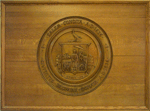Hathorne, John: Difference between revisions
From Salem Links and Lore
No edit summary |
No edit summary |
||
| Line 3: | Line 3: | ||
He was also commander-in-chief against the Indians in 1696. | He was also commander-in-chief against the Indians in 1696. | ||
*He is best known, however as the "witch judge" or the "hanging judge" as he was a magistrate | *He is best known, however as the "witch judge" or the "hanging judge" as he was a magistrate of the Court of Oyer and Terminer and the | ||
of the Court of Oyer and Terminer and the chief interrogator of the accused witches in the Salem witchcraft hysteria of 1692. John Hathorne is interred | chief interrogator of the accused witches in the Salem witchcraft hysteria of 1692. | ||
at the Charter Street Burying Point in Salem. | |||
*John Hathorne is interred at the Charter Street Burying Point in Salem. | |||
Revision as of 08:30, 26 April 2013
- John Hathorne (1641-1717) was son of Major William Hathorne and author Nathaniel Hawthorne's (born Hathorne) great-great-great paternal grandfather.
Justice John Hathorne was the third son of Major William and Anna Hathorne. He became a prosperous merchant in Salem and a judge on the Superior Court. He was also commander-in-chief against the Indians in 1696.
- He is best known, however as the "witch judge" or the "hanging judge" as he was a magistrate of the Court of Oyer and Terminer and the
chief interrogator of the accused witches in the Salem witchcraft hysteria of 1692.
- John Hathorne is interred at the Charter Street Burying Point in Salem.
